July 31, 2015
Air Date: July 31, 2015
FULL SHOW
SEGMENTS
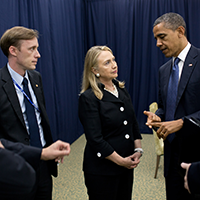
The Hillary Clinton Campaign Goes Solar
View the page for this story
Democratic Presidential front-runner Hillary Clinton has pledged to create and enlarge market-based incentives to boost renewable energy in the US, as part of her fight against global warming. Her plan includes installing half a billion solar panels in her first four years in office and producing a third of all US electric power from renewable sources by 2027. In conversation with host Steve Curwood, Secretary Clinton’s policy director Jake Sullivan lays out how they plan to meet those goals, and explains Secretary Clinton’s position on controversial fossil fuel projects including Keystone XL. (12:30)

At Risk the Pangolin- A Mammal With Scales
View the page for this story
The pangolin is the world’s most illegally traded mammal, poached by the hundreds of thousands from Southeast Asia and African savannahs and sold in Asia as medicine. But a market for this scaly anteater exists in the US too, and with little protection here, trade is helping to push them towards extinction. Host Steve Curwood speaks with the Center for Biological Diversity’s Sarah Uhlemann about the pangolin’s global decline and why US protections under the Endangered Species Act are necessary to help save this unique creature. (06:20)
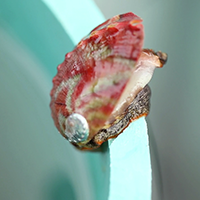
Abalone Back From The Brink
/ Ashley Ahearn and Ken ChristensenView the page for this story
The pinto abalone of the Northwest’s Puget Sound are a delicacy in Asia, prized for their meat and beautiful shell. As a result they were poached nearly to extinction in the early 1990s, but as EarthFix reporter Ashley Ahearn explains, with a little help from scientists, the wild abalone is slowly recovering. (04:45)
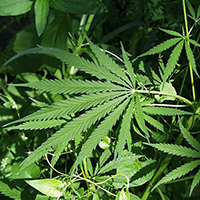
Beyond the Headlines
/ Peter DykstraView the page for this story
In this week’s trip beyond the headlines, Peter Dykstra tells host Steve Curwood about how limiting coal power plant emissions has led to lower mercury levels in bluefish and describes a new certification program that encourages marijuana growers to use environmentally-friendly, organic farming practices. (04:30)
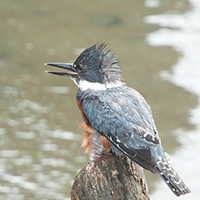
BirdNote®: Where Are All The Queen Birds?
/ Michael SteinView the page for this story
There are plenty of “queens” of the animal kingdom, like the Queen Snake, Queen Butterfly, and queen bees and ants. But the only royal birds, it seems, are ones that carry the title “king” – think kingfishers, kinglets, and the King Vulture – as BirdNote®’s Michael Stein notes, there don't seem any birds with "queen" in their name. He explains why. (01:55)
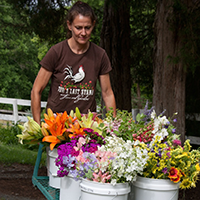
Woman Power and Small Farm Success
View the page for this story
Women are increasingly joining the "back to the land" and local food movements as farmers. Host Steve Curwood spoke with farmer and author Audrey Levatino, who has written Woman Powered Farm: Manual for a Self-Sufficient Lifestyle from Homestead to Field. Her book is for anyone who would like to start farming, with special hints for women and anyone wants sustainable and back-saving approaches to the rigors and joys of tending life on good dirt. (16:00)
Show Credits and Funders
Show Transcript
HOST: Steve Curwood
GUESTS: Jake Sullivan, Sarah Uhlemann, Audrey Levatino
REPORTERS: Ashley Ahearn, Peter Dykstra, Michael Stein
[THEME]
CURWOOD: From Public Radio International, this is Living on Earth.
[THEME]
CURWOOD: I'm Steve Curwood. Democratic Presidential candidate Hillary Clinton unveils her plans to fight global warming with ambitious renewable energy goals.
CLINTON: Future generations will look back and wonder - what were we thinking? How could we possibly be so irresponsible? I'm just a grandmother with two eyes and a brain, and I know what's happening in the world is going to have a big effect on my daughter and especially on my granddaughter.
CURWOOD: Also, shellfish rustlers in Puget Sound have driven abalone to the edge of extinction.
WELCH: He said, well, I myself have stolen enough abalone in Puget Sound to buy this commercial boat that I own, and to buy my Jeep Cherokee. And I can tell you that there are many other people poaching at the same level. So we’re talking tens of thousands of dollars.
CURWOOD: But now, scientists have found an answer. That and more this week on Living on Earth. Stick around.
[NEWSBREAK MUSIC: Boards Of Canada “Zoetrope” from “In A Beautiful Place Out In The Country” (Warp Records 2000)]
ANNOUNCER: Support for Living on Earth comes from United Technologies – innovating to make the world a better, more sustainable place to live.
[THEME RETURN]
The Hillary Clinton Campaign Goes Solar
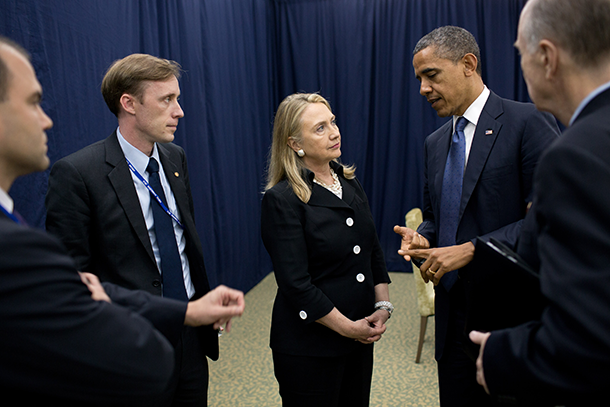
Jake Sullivan, former national security advisor to Vice President Biden, and Hillary Clinton, former Secretary of State, speaking with President Barack Obama. (Official White House Photo by Pete Souza)
CURWOOD: From the Jennifer and Ted Stanley Studios in Boston and PRI, this is Living on Earth. I’m Steve Curwood. With polling that suggests two-thirds of voters want the next president to address climate change, Hillary Clinton has laid out an ambitious renewable energy plan while campaigning in Iowa and New Hampshire. The present front-runner for the democratic nomination declared she would take action on day one of her presidential term.
CLINTON: First, I will ensure we hit a target of having more than half a billion solar panels installed across the country by the end of my first term. Second, we'll set a ten-year goal of generating enough renewable energy to power every single home in America.
CURWOOD: Jake Sullivan, senior policy analyst for the Clinton campaign says that amounts to about a third of all US electricity, and she’s taking these steps because she believes climate change is one of our defining challenges. Jake Sullivan says her measures build on President Obama’s legacy.
SULLIVAN: So the first step is to defend and implement the smart environmental and public health standards like the Clean Power plan that the President has laid out, and to ensure that that is rigorously implemented and defended against efforts by Republicans in Congress to roll it back. But then beyond that, what the Secretary has talked about is launching what she calls a new Clean Energy Challenge which is essentially a partnership with states, cities, and rural communities that will involve competitive grants and other market-based tools, so anyone who wants to go above and beyond the floor set by the Clean Power plan, anyone who wants to cut red tape that hinders clean energy access and entrepreneurship to invest in a more reliable electrical grid through whatever mechanism or means they think really works. Any city government or state government, there will be resources available to them from the federal government to do that.
CURWOOD: So let's look at your call for a half a billion solar panels by 2020 and in her first term, assuming she would win one. How does that work? How would that work? And what would you require in terms of legislation?
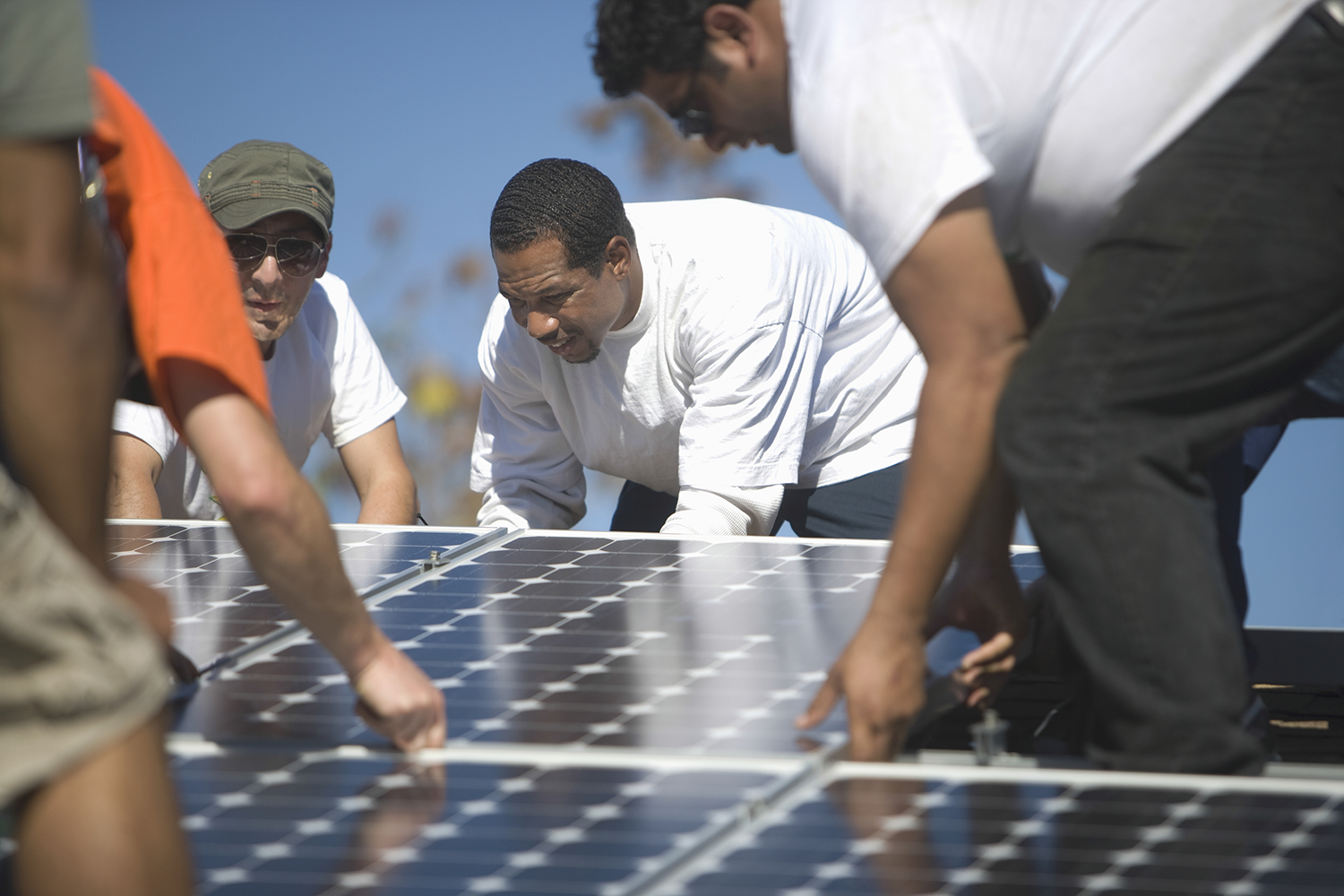
Secretary Clinton is calling for half a billion solar panels in her first term if elected (Photo: Bigstock photo)
SULLIVAN: So a substantial amount of it will be about removing barriers to the deployment of energy through cutting red tape, and that would be partly through incentive grants to cities and states. A substantial part of it will be through the extension and improvement of the renewable energy tax credits that have been so instrumental in helping drive the remarkable strides we've seen taken on solar and other forms of renewable energy, and then part of it will be about giving cities, states, local governments, tools to make their own choices about the best ways forward, whether that's new financing facilities, new types of incentives for deployment, new partnerships with labor and business and others, and we believe that if you put all of those pieces together and you harness what has already been a clean energy...the beginnings of a clean energy revolution in this country, it is ambitious but achievable to get to the 700 percent increase from current levels and in the deployment of installed solar capacity.
CURWOOD: How do you pay for this?
SULLIVAN: Well, let me start by saying that we don't look at this strictly as a cost. We look at this as an investment: an investment in jobs, an investment in public health, an investment in the transformation of our economies so that we become a clean energy superpower. But it will take resources and we've estimated that it will cost us around $60 billion over 10 years which can be set off by closing the loopholes that have basically given away subsidies and other breaks to oil and gas companies both directly and indirectly that add up to roughly that amount, roughly $60 billion.
CURWOOD: You're talking about cutting subsidies for fossil fuels.
SULLIVAN: That's right.
CURWOOD: Now, Republicans have criticized Secretary Clinton's plan, saying it's going to raise utility bills, what you say to that?
SULLIVAN: We don't see any reason why the transformation to a clean energy economy should do anything other than actually make, over time, energy and electricity more reliable and more affordable, so we simply do not accept the argument that the Republicans are making that this is going to drive up energy costs. We think that already, as you give more consumer choice and more capacity to customers and homeowners to decide how they want to power their homes, many of them are choosing solar or wind-based systems, and in places like Iowa, wind is growing dramatically. In places like New Hampshire, you're seeing a major uptick in solar and you aren't seeing the kind of parade of renewables that Republicans have suggested you would see.
CURWOOD: Now, some of the other Democratic candidates have called for a carbon tax. What's the position of Secretary Clinton on that?
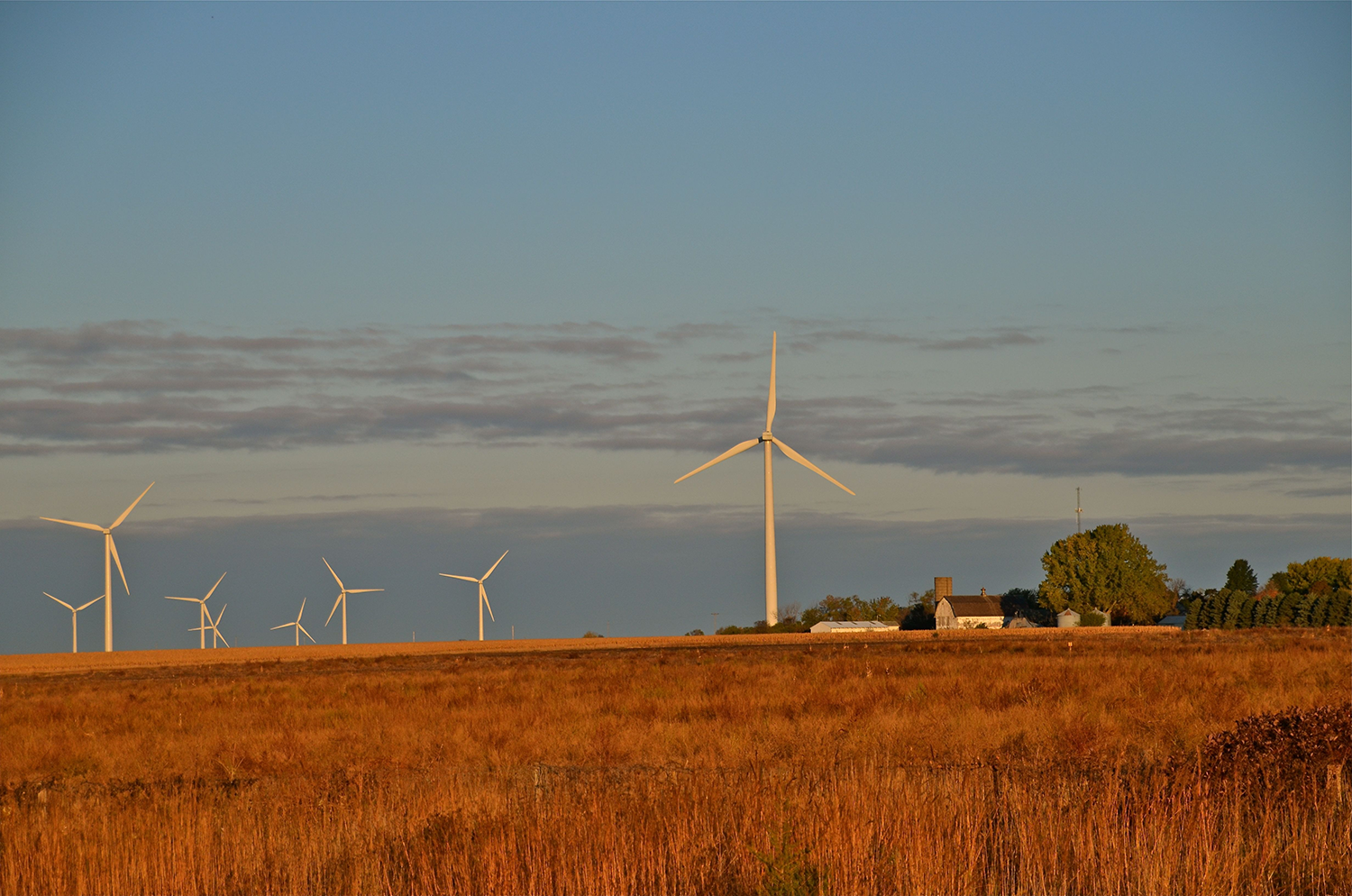
Secretary Clinton also called for a third of all US electricity to be produced from renewable sources within ten years of the next president taking office. (Photo: Bigstock photo)
SULLIVAN: Secretary Clinton thinks that we need to think very seriously about market-based tools to be able to incentivize the kind of transformation we need and that's part of what's built into her Clean Energy Challenge, but on that issue specifically which she's concerned about is that that kind of tool could end up really falling onto the backs of the middle-class, so she has been exploring and consulting with a range of different experts and advocates on this to figure out how do we go about making sure we have a clean energy transformation that doesn't end up hurting the middle class, but in fact ends up helping them, and that's why the plan she's laid out is a plan that is heavily based around the kinds of taxes and other incentives that can drive city, state, local, innovation with the federal government standing behind it.
CURWOOD: Now, a number of environmental groups and other folks have applauded the plan, but there are some folks who have concerns about the Secretary's position on climate change. Bill McKibben told a newspaper the other day that Hillary Clinton is "halfway there...now we need her to show she understands the other half of the climate change equation and prove she has the courage to stand up to fossil fuel projects like offshore and Arctic drilling, coal leasing in the Powder River Basin and the Keystone XL pipeline.” So let's go through a few of these one by one. What does the candidate stand on offshore and Arctic drilling at this point?
SULLIVAN: Well, she's going to be speaking more specifically about issues relating to drilling and I don't want to steal her thunder or get too far ahead of her. I will say that she has expressed skepticism about the need for opening new areas in the Arctic, but on the broader issue of how to think about the role of fossil fuels in the system and how we reduce the amount of oil consumed in United States, this is something that she has already said that she's going to be laying out in detail in the coming weeks.
CURWOOD: Now, what about coal leasing in the Powder River Basin? Right now the lease rates are extremely low and the stuff gets exported to other countries. Coal is going down here, but other countries are using it. Of course, any molecule of CO2 affects global warming no matter where it is in the atmosphere. It would seem that coal leasing makes it more difficult to address the carbon situation. What does the candidate say?
SULLIVAN: With respect to how we deal with it, the broader issue of coal and also with the crucial importance of helping coal communities that are transitioning away, this is another one of the significant aspects of her program that she hasn't rolled out yet and again I don't want to steal her thunder on it, but she'll be laying out her views in detail on the specific question of coal leasing but also the broader set of issues around the transformation of our economy away from coal.
CURWOOD: Let me ask this question then. People in coal mining country, particularly the miners, for generations, have given their lives, their health, to make it possible for you and I to be talking on this electronic circuit. I'm sure there is some coal power and electrons here. What's Hillary Clinton going to do to make sure that these folks aren't roadkill in this massive switching in our economy? They've sacrificed a lot.
SULLIVAN: This is such an important question, and it's something that she's spoken to already a few times in this campaign. I mean the bottom line is, and she's made this point, is, and you just alluded to, is that American coal miners have kept our lights on, they've kept our factories running for more than a century. They've put themselves at risk. They've built communities that have formed the backbone of the development of this country. And we can't forget that. So I think one of the things that she will be very much focused on is to make sure that we follow through on our responsibility to guarantee the coal miners get the benefits they've earned, and to ensure that nobody turns their back on the coalfield workers and communities as we transition. Just a few days ago, she laid out some of her tax proposals, she specifically focused on what we could do to create new investments in hard areas including coal communities, and she'll have more to say to that as this campaign goes on.
CURWOOD: Right now, the price of oil is pretty low and companies have been pulling out of the tar sands area in Canada, but there's a lot of pressure to put in the pipeline for Keystone XL as well. Where's Secretary Clinton on Keystone?
SULLIVAN: This is a somewhat unique issue because it involved her in a direct way when she was Secretary of State. When she was Secretary, she launched a deliberative and evidence-based process that was designed to evaluate the environmental impact and all of the other national interest considerations of Keystone, and given that an evaluation is currently underway and a final decision is pending before Secretary Kerry and President Obama, she has not thought that it was appropriate, given her past position and her role in watching this process, to weigh in on the Keystone pipeline issue before it's completed. But she has said that she's confident that the pipeline's impact on global carbon emissions will be a major factor in the decision and she thinks that that's entirely appropriate.

While some activists praised her climate plan, others criticized Secretary Clinton for not taking a stand against controversial fossil fuel projects like the Keystone XL pipeline. (Photo: TarSandsAction, CC BY 2.0)
CURWOOD: One of the concerns about shifting our economy to renewable energy is that the very wealthy fossil fuel industries have put a lot of money into elections to get lawmakers who push back against that, who are friendly to their interests. So the question is this about your campaign: To what extent are you accepting money from the fossil fuel industry?
SULLIVAN: (LONG PAUSE) Well, I guess it depends on what you mean when you say "accepting money from the fossil fuel industry". You know, the Secretary obviously receives contributions from a wide variety of sources, but when it comes to taking a firm stand on the issues related to the types of loopholes and other incentives that have been basically just giveaways to the oil and gas industry, she's taken an incredibly firm position, so even in this plan she's talking about tens of billions of dollars of loopholes and other types of incentives to oil and gas that she wants to strip from them and take away from them. And her record on that going back to her days in the Senate, I think proves that she's prepared to stand up for clean energy and again special breaks from oil and gas, on a consistent and clear basis, and that's exactly how she would pursue things as president.
CURWOOD: Now many scientists say that we really don't have much time, certainly not even a decade to take strong action on climate to avoid catastrophic disruption. Given that how important are these issues for the next president of United States do you think?
SULLIVAN: Well this is why she’s setting these targets at something a lot shorter than 2050. So one of her targets, the solar deployment target, is by the end of her first term, within four years, and the second is within 10 years of her taking office and it's because she believes that the next several years are going to be decisive in terms of whether we're going to be able to get ourselves on a pathway to deep decarbonization, and so it will be from day one her charge and her commitment to be driving these goals to fruition and to be making the kinds of changes in our economy and our energy mix that are necessary to be able to confront this challenge.
CURWOOD: Jake Sullivan is a senior policy director for former Secretary of State Hillary Clinton's presidential campaign. Jake, thanks so much for taking the time with us today.
SULLIVAN: Thank you so much for having me.
Related links:
- About the Clinton energy plan on her campaign’s website
- Jake Sullivan isSenior Policy Director for the Clinton Campaign
- Video of Hillary Clinton on the climate challenge and clean energy
[MUSIC: Charlie Hunter, Think of One, Copperopolis, Charlie Hunter Music, 2006]
CURWOOD: Coming up...they are shy and elusive, but friends of the Pangolin are seeking the spotlight to save this unusual mammal. Stay tuned to Living on Earth.
[CUTAWAY MUSIC: Medeski, Martin and Wood, Chasen vs Suribachi, Radiolarians 11, Indirecto 2009]
At Risk the Pangolin- A Mammal With Scales
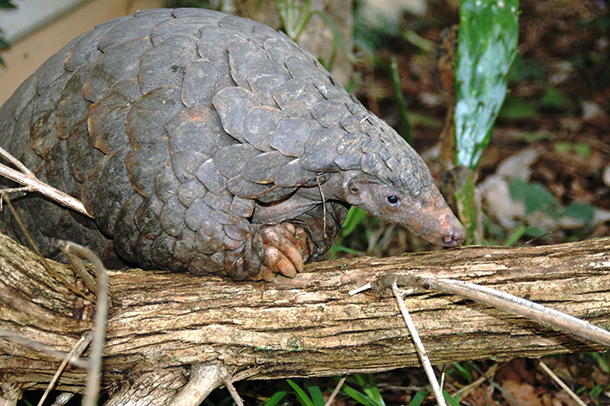
There are eight species of pangolin: four are native to Asia and the others to Africa. They are generally nocturnal, solitary creatures, whose diet consists mostly of ants and termites. (Photo: Tikki Hywood Trust)
CURWOOD: It's Living on Earth. I'm Steve Curwood. Quiz time now - what’s the mammal that tops the illegal wildlife trade? If you answered the elephant – or rhino – or tiger, you certainly fingered some of the planet’s most threatened and charismatic creatures, but according to the Center for Biological Diversity there’s one mammal more trafficked than all of these combined. It’s a scaly anteater called the Pangolin. Now there’s a new push to protect Pangolins, by adding them to the US Endangered Species List. Sarah Uhlemann of the Center for Biological Diversity joins us now.
Welcome to Living on Earth.
UHLEMANN: Thank you I'm so grateful to be here.
CURWOOD: So this is the most trafficked mammal in the world, as I understand it. What is it?
UHLEMANN: So this really is one of the coolest and most bizarre animals that I know of. They're mammals; they're about the size of a cat, they're essentially anteaters. They have a tongue that's about the size of their body. They range in different shades of brown, and they're covered literally from tip to tail with these large scales. So they sort of have this geometric look to them. Adorably odd, I would say, kind of like tanks with tails, and what really adds to their cuteness is unfortunately a factor in their demise, and that's their self-defense mechanism. When these little guys gets scared, they essentially roll up into a little ball and this is a very effective defense mechanism against, say, a tiger. They can't really chew through the Pangolin scales, but it makes poaching a breeze. You just scare the little guys, they roll into a ball, pluck them up in your bag and off you go.
CURWOOD: And why is it so endangered?
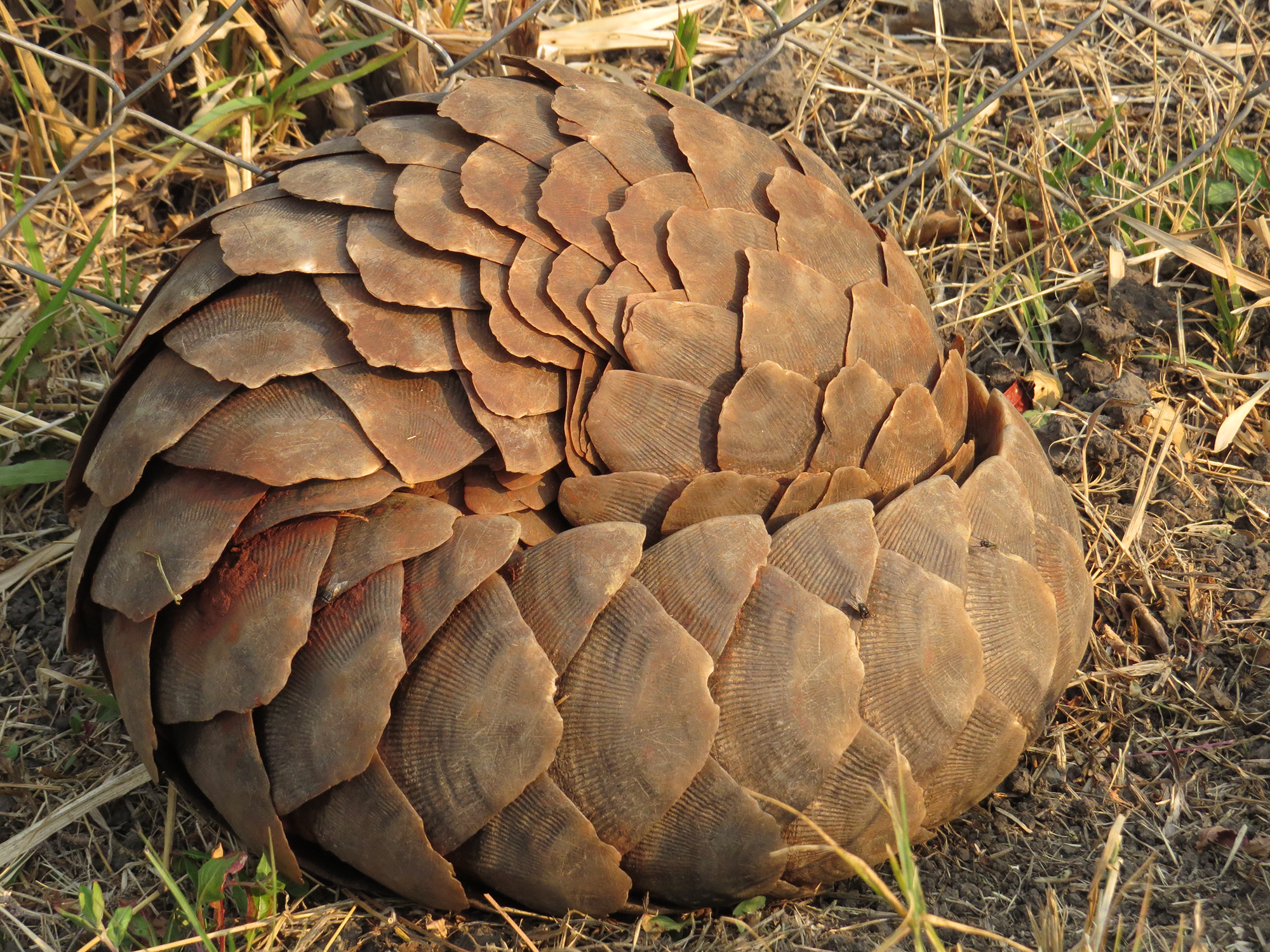
"Pangolin" comes from the Malay word "pengguling", meaning "something that rolls up". When pangolin are frightened, they roll up into a tight ball. Their tough keratin scales protect them from animal predators, but this defense mechanism does little to protect them from poachers. (Photo: Tikki Hywood Trust)
UHLEMANN: Well, they face two threats and they're both from human consumption. One is that their meat is considered a delicacy in China. They're also sometimes eaten as bushmeat in Africa, but it's really consumption in China that's the problem. The second way that they're consumed is that their scales are used in Asian medicine. They're made of keratin, so exactly the same thing that your fingernails are made out of. So it supposedly treats a variety of ailments, everything from dispersing congealed blood to promoting menstruation, dispelling stiffness and swelling, healing liver problems. But I really want to emphasize that there's absolutely no scientific evidence that Pangolin scales have any medicinal benefits.
CURWOOD: Where are these being trafficked to?
UHLEMANN: Most of the legal trade is going to China and Southeast Asia, particularly to Vietnam. However, there is a sizable market here in the United States which I think really surprises people. We did an investigation and looked at the imports of Pangolins into the United States and found 26,000 different imports since 2004. A lot of these scales have been confiscated, but the reality is there still is a market here in United States, and that's exactly what we want to solve with our petition to list these animals as endangered - really shut off the legal market here in United States.
CURWOOD: So give me some numbers here. How many are being trafficked and how many are left and how fast are they in the process of going away?
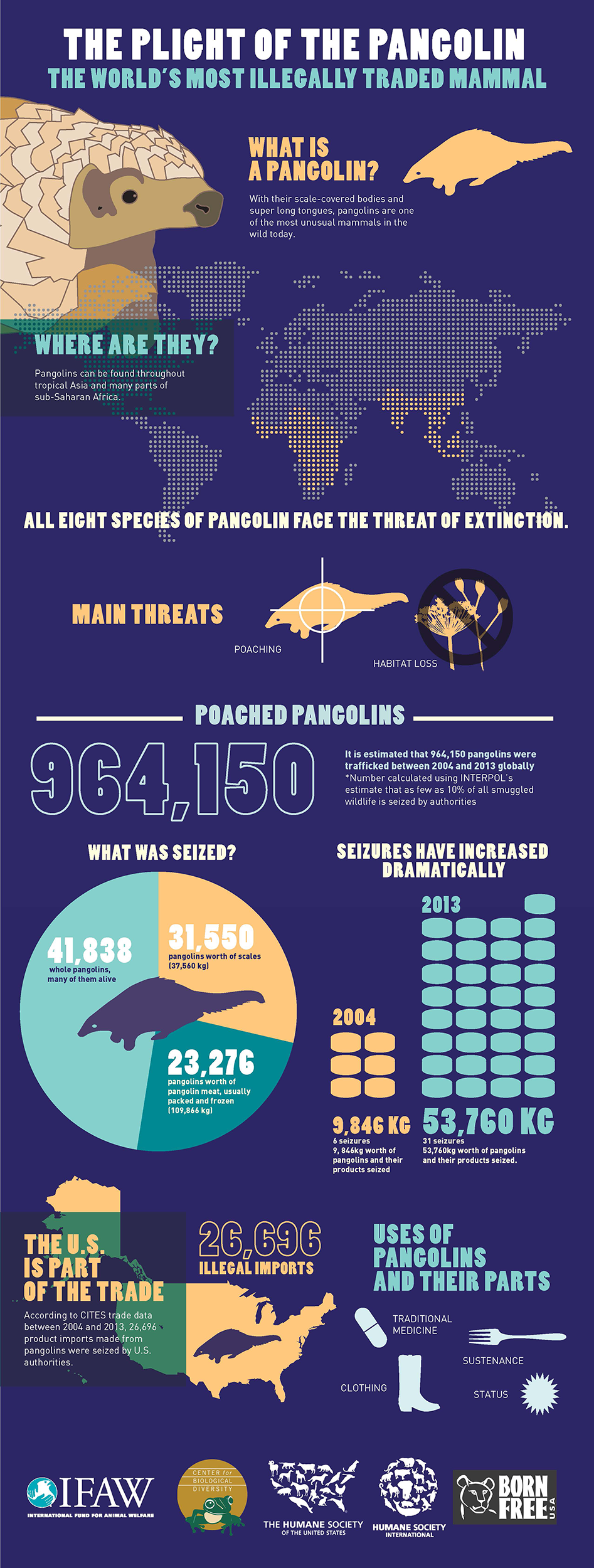
(Photo: International Fund for Animal Welfare)
UHLEMANN: There are some things we don't know about Pangolins. They are a species that scientists have just started researching. But what we do know is they are in very severe decline. One example I can give you is the Chinese Pangolin. This is the species that has already suffered to severe declines and if trends continue, we're supposed to have 90 percent of them disappear in the next 20 years. That's getting awfully close to extinction. So we don't really have a great estimate for how many there are existing left unfortunately, but what we do know is that over the past decade about a million have been taken out of the wild and our new research indicates that about 960,000 of those were illegally trafficked, making them of course the most illegally trafficked mammal in the world. But these species may disappear before most people even know that they exist, or ever even heard of them.
CURWOOD: So what are we talking about in terms of money? What do people get?
UHLEMANN: So there is an increasing market, it seems, for Pangolins given the increasing price of them. Right now you can get a kilogram of scales for about $600 US and that's twice the amount that they were going for back in 2008.
CURWOOD: So what's the international protection of these animals?
UHLEMANN: Well, right now there are four species of Asian Pangolins and all of those Pangolins are protected against commercial trade by the CITES treaty, this is the treaty that prohibits commercial trading of endanger species. Despite these protections, however, illegal trading of Asian Pangolins is absolutely rampant. We're seeing a vast increase in both the numbers of seizures, but also the numbers of animals actually found in those seizures.
Unfortunately, the four species of African Pangolins have absolutely no protections at this point. As the demand for Pangolin scales is increasing in Asian, most of the Asian Pangolins have virtually been exterminated. So the eyes of trade have unfortunately turned to the African Pangolin, so we're seeing a lot more of those species declining as well. However, when the Pangolin scales are ground-up powder, which is the form that they're most traded in, you can't tell the difference between an Asian protected penguin and a non-protected African Pangolin.
CURWOOD: Now, your group and some others have petitioned to list the Pangolin under the Endangered Species Act, so how likely is it that you'll get that listing, and what would be the outcome of the Pangolin?
UHLEMANN: That's right. My organization, the Center for Biological Diversity as well as our colleagues have petitioned to list the seven species of Pangolins as endangered under the US Endangered Species Act. There is already one species of Pangolin, the Temminck's Pangolin that is currently listed as endangered under that act. We are very hopeful that the US Fish and Wildlife Service will agree with us because Pangolins are in deep, deep trouble, and we're going to lose them very soon if we don't seek their protection very soon, but I think if people realized that their choices were potentially extinguishing the existence of this incredible species that they would change their choices and not be purchasing Pangolins anymore. So part of what the Endangered Species listing is going to do is really raise the profile, and raise awareness about the Pangolin and its threats.
CURWOOD: Sarah Uhlemann is International Director with the Center of Biological Diversity. Thanks so much for taking time with us today, Sarah.
UHLEMANN: Well, thank you so much Steve, I really appreciate it.
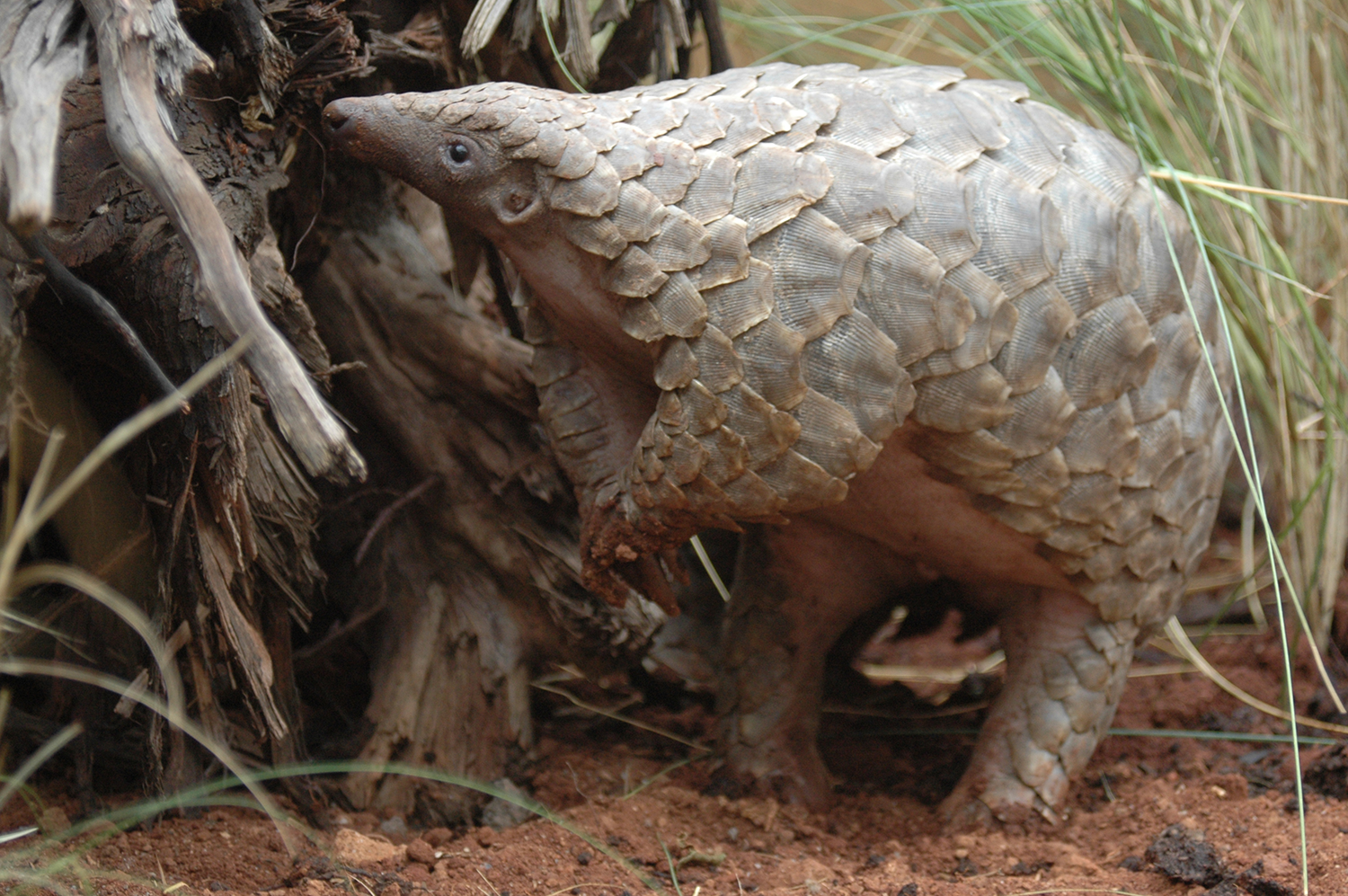
Pangolin have tetrapod claws. Their front claws are long and good for digging to find insects, but they would make walking difficult. In order work around this, pangolin tuck their front claws under and walk somewhat upright on their hind legs. Their long tail helps them to balance. (Photo: Tikki Hywood Trust)
Related links:
- Petition to ESA list 7 pangolin species as endangered
- ESA petition to list under “Look Alike” provision
- Born Free USA: ESA petitions and pangolin trade data
- Center for Biological Diversity helped draft ESA petitions
- The Humane Society International: Planning Conservation Actions
- International Fund for Animal Welfare: Pangolin Range States Meet
- Rich Chinese are literally eating this exotic mammal into extinction
- A Struggle to Save the Scaly Pangolin
- In Vietnam, Rampant Wildlife Smuggling Prompts Little Concern
- Capturing pangolin traffickers in Southeast Asia
Abalone Back From The Brink
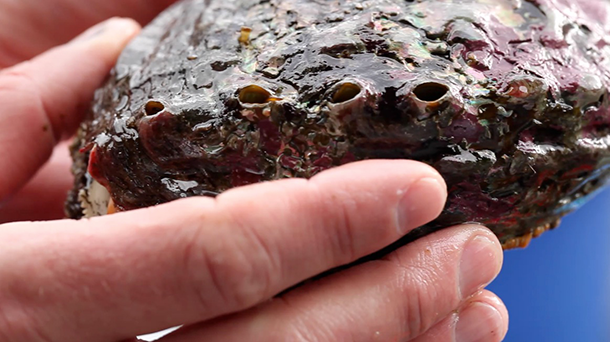
Pinto abalone (Photo: EarthFix/ Oregon Public Broadcasting)
CURWOOD: Well, the Pangolin is not the only creature threatened by appetites in Asia – so is the shellfish, the abalone. Pinto abalone are such a delicacy there, they became a target for poachers after their meat and their mother of pearl shell and were driven virtually to extinction by the end of the 1990s. So many thousands of abalone were taken from Puget Sound, they seem to be failing to reproduce. But as Ashley Ahearn from the public media collaborative EarthFix reports, scientists working in their labs are giving the Pinto abalone new hope – and maybe a new lease on life.
BOUMA: Just get this tank lid off here.
AHEARN: You can hear the pride in Josh Bouma’s voice as he peers down into a tank at the NOAA labs in Mukilteo. Bouma is a shellfish biologist with the Puget Sound Restoration Fund and manages a captive breeding operation for Pinto abalone. He’s raised these abalone from tiny larvae.
BOUMA: I’ll show you one of our adult broodstock animals as well. The adult Pinto abalone’s oval shell shines a deep, ruby red. This is the only type of abalone native to the waters of the Northwest but there are so few of them left in Puget Sound that scientists say they aren’t reproducing. Since the early 90s, the population has decreased by more than 90 percent. Pinto abalone are shy creatures. In the wild, they hide in rocky underwater crevices to avoid predators. But in the lab, Bouma had to improvise.

Josh Bouma, a shellfish biologist with the Puget Sound Restoration Fund, leads a team that has raised nearly 7,000 juvenile abalone in a hatchery. (Photo: Katie Campbell, KCTS9/EarthFix)
BOUMA: Those are, we call them abalone condos. It’s basically a piece of PVC pipe cut in half. They really like dark overhangs. They like to be in places where they feel safe.
AHEARN: The Pinto abalone scuttles out from beneath its hiding place, its fleshy spotted undercarriage shuttles it along like a lady running in long, rippling skirts. It’s that tasty flesh that got this shellfish into so much trouble. The meat is a delicacy in Asia, where illegally-harvested abalone from Puget Sound used to fetch top dollar.
WELCH: Abalone poaching in Puget Sound throughout the late 80s and early to mid 90s was huge.
AHEARN: Craig Welch was a reporter for the Seattle Times during the heyday of abalone poaching. He wrote a book about it, called Shell Games: Rogues, Smugglers and the Hunt for Nature’s Bounty. In the book, Welch profiles an abalone poacher named Dave Ferguson. He was a tough guy - had done prison time before he got busted with illegally harvested abalone in 1994. And Ferguson had poached a LOT of abalone - enough to buy an expensive fishing boat he flamboyantly named the Abalone Made, that's m-a-d-e. But when the cops busted him, he wasn’t so tough. Welch says he told them everything.
WELCH: He said, "Well, I myself have stolen enough abalone in Puget Sound to buy this commercial boat that I own, and to buy my Jeep Cherokee. And I can tell you that there are many other people poaching at the same level." So we’re talking tens of thousands of dollars over the course of months and months, so it was a lot.
AHEARN: Instead of doing jail time, Ferguson began working as an undercover agent for the Department of Fish and Wildlife. He led officials to numerous busts and clued them in on the dark underbelly of shellfish trafficking in Puget Sound. But he eventually skipped town and officials haven’t heard from him since.
[BOAT ENGINE SLOWING DOWN]
AHEARN: Pinto abalone are still struggling to recover, and scientists like Josh Bouma and others are trying to help.
SIZEMORE: OK, we’re here.
[BREATHING IN DIVE GEAR, ENGINE SOUNDS]
AHEARN: Today, the team is putting on dive gear, grabbing tubes full of young abalone they raised in the lab, and jumping off the back of the research boat.
[SPLASH OF DIVERS JUMPING OFF BOAT]
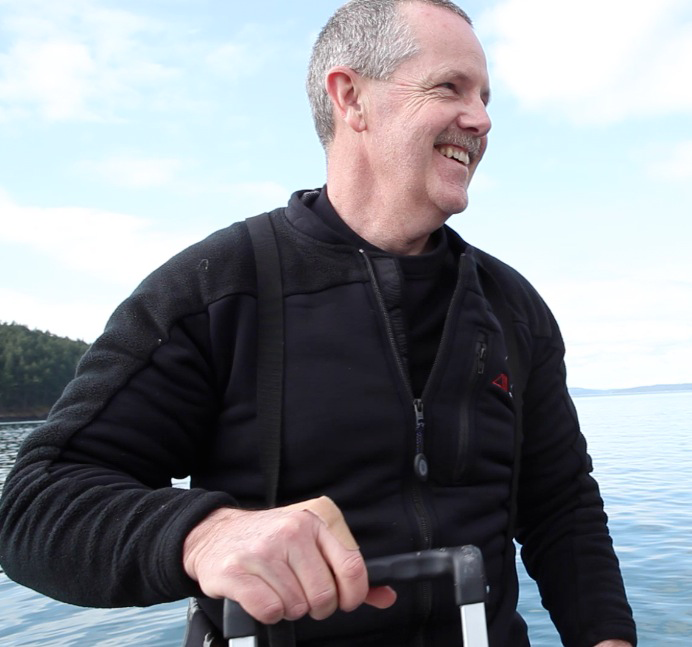
Bob Sizemore, a research scientist with the Washington Department of Fish and Wildlife, said poaching and overharvesting spurred a 20-year decline in pinto abalone populations. (Photo: Katie Campbell, KCTS9/EarthFix)
They’ll dive 35 feet or so below where we’re idling off the coast of a rocky island in the San Juans. Then they’ll deposit the young abalones. These creatures are broadcast spawners. That means that males and females meet up and release sperm and eggs into the water to make larvae. But if there aren’t enough adults, that can’t happen. So for the past five years the team has been releasing young abalone at a handful of sites around the San Juans. They tag them so they can ID them later on.
Bob Sizemore has been monitoring abalone since the 90s for the state Department of Fish and Wildlife. He says that now, when they go back to sites like this, they’re seeing the same babies they released.
SIZEMORE: This is the best. This is a culmination of lots and lots of work...and it feels good to have all these efforts come to a point in time where we can make a difference. It’s awesome.
AHEARN: In these small pockets of Puget Sound, Sizemore says the population has grown to levels where there are now enough adults to spawn naturally.
I’m Ashley Ahearn in the San Juan Islands.
CURWOOD: Ashley reports for the public media collaborative, EarthFix. There are photos and video from this series on the illegal wildlife trade at our website, LOE.org.
Related links:
- EarthFix/OPB series Wildlife Detectives
- More on the abalone's recovery on EarthFix
[MUSIC: John Hartford, I am a Man of Constant Sorrow, O Brother, Where Art Thou? Soundtrack, Mercury/Lost Highway 2000]
Beyond the Headlines
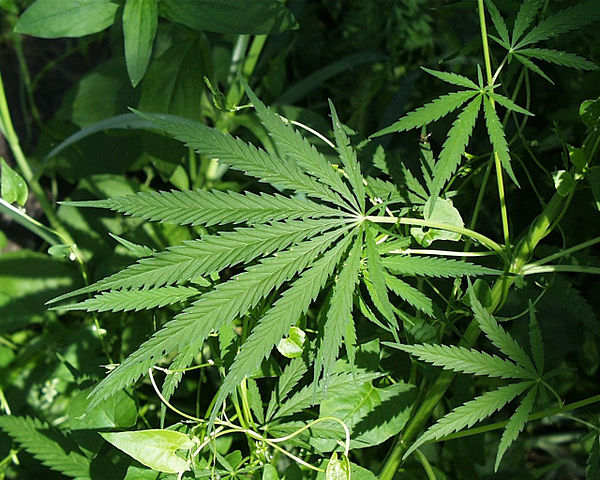
Marijuana: The USDA might not be springing to certify 'organic' marijuana just yet, but some growers say it's time for pesticide-free pot. The Clean Green certification program hopes to discourage growers from spraying pesticides to fight pot pests like spider mites and root aphids—these chemicals often contain neurotoxins and carcinogens. (Photo: US Fish and Wildlife Service, Wikimedia CC Public Domain)
CURWOOD: Time to check in now with the world beyond the headlines with Peter Dykstra. Peter’s part of the team at Environmental Health News, that’s EHN.org and DailyClimate.org, and he joins us on the line from Conyers, Georgia. Hi there, Peter.
DYKSTRA: Hi, Steve, I know when we talk about environmental headlines, not all of them are cheerful, so let’s start with a success story about one of my favorite ocean fish: Bluefish. They’re abundant, relatively cheap in the store, they can be particularly difficult on the hook if you catch them yourself and to me they’re tasty, though they’ll stink up the house if they aren’t absolutely fresh when you cook 'em. The good news is what’s being found in Bluefish in smaller quantities: mercury levels in Atlantic bluefish have dropped by about 40 percent in the last few decades.
CURWOOD: That’s a huge improvement, Peter. What’s caused it?
DYKSTRA: Coal burning is the major cause of mercury deposition. Clean air regulations have helped cause a sharp drop in mercury emissions from coal plants, and the current dismal economic picture for coal means there are fewer coal plants in operation. Smokestack mercury from coal plants comes back to Earth, much of it’s dropped in the oceans, and some of that ends up in fish. A study in the journal Environmental Science and Technology reports that bluefish caught off the North Carolina coast recently have a dramatically lower amount of mercury than fish caught in the same waters in 1972. The researchers were quick to credit pollution limits on coal burning for the improvement.
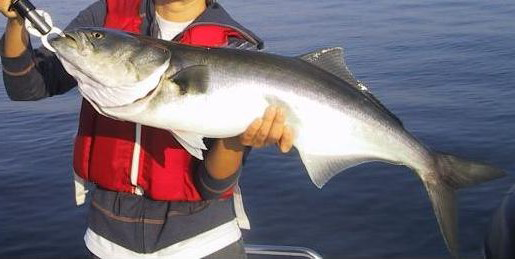
Mercury concentrations in bluefish have decreased by more than 40% since the emergence of clean air regulations in the 1970s aimed at coal-fired power plant emissions. Scientists were surprised by the quick results; they didn't expect to see any changes for over a century. (Photo: CyberAnth, English Wikipedia CC BY-SA 3.0)
CURWOOD: So, good news all around. What’s next?
DYKSTRA: Let’s do a little mythbusting, or maybe it’s icon-busting. If you go back a few decades, we tend to think of the dawn of the environmental movement and the dawn of marijuana culture as closely related.
CURWOOD: Yeah, but we’ve heard an awful lot about how pot-growers can be a real downer for the environment.
DYKSTRA: Absolutely, we have. Today, many cannabis growers stand accused of massive water and electric use, damage to streams and wildlife, overuse of pesticides and more, all at a time when recreational marijuana use has become legal in four states and the District of Columbia, and they’ll possibly be passing the, uh, torch to other states in the next few years. Enter the Clean Green certification program for marijuana farmers.
CURWOOD: High Seal of Approval for pot farmers?
DYKSTRA: According to Clean Green, they’ve received paperwork, inspected, and certified nearly a hundred Oregon pot farms for environmentally responsible farming methods, water conservation, and limiting pests without pesticides. They say the goal is to meet US government standards for “organic” crops. But the USDA isn’t yet in the mood to certify a crop that the US government still says is illegal, so we’ll see how it all comes out when the smoke clears.
CURWOOD: So, I guess some day we’ll see a Blue Ribbon Weed at the state fair?
DYKSTRA: That’d be different!
CURWOOD: [CHUCKLES] Hey, what have you got for us on the history calendar this week?
DYKSTRA: Forty years ago, in August 1975, Edward Abbey published his novel “The Monkey Wrench Gang,” about a band of misfits with a passion for the landscape of the American West. They were led by an ex-Green Beret named George Hayduke who returned from Vietnam to find his favorite place threatened by development.
Hayduke and his gang deployed sabotage in the name of protecting nature, but a few years later, Abbey’s fiction became fact for Earth First!, whose activists used sabotage to oppose development near wilderness.
CURWOOD: Yeah and to this day they’re heroes to some, domestic terrorists to others.
DYKSTRA: There’s a new documentary making the rounds, screening over the next few months at venues throughout the West. It’s called “Wrenched,” and it’s about the real-life versions of George Hayduke.
Edward Abbey wrote several other books, notably one called “Desert Solitaire,” which was written seven years before the Monkey Wrench Gang. It’s where Abbey first pours his heart out about his love for the West. He died in 1989, was reportedly buried on public land in a sleeping bag, and rests beneath a headstone that reads “No Comment.”
CURWOOD: How can you top that?
DYKSTRA: Well, this doesn’t top it, but I need to correct some info I gave a few weeks ago in a segment on Arctic oil exploration. Shell is hoping to drill in a portion of the Arctic known as the Chukchi Sea, off the Northwest Alaska coast. Several hundred miles to the east, several other oil projects are on hold in the Beaufort Sea, off Canada’s Northwest Territories. The Shell rigs will be in fairly shallow water, not in the deep ocean as I said. I should know better. Thanks to a listener in Fairbanks, Alaska for straightening me out.
CURWOOD: Indeed. Peter Dykstra is with Environmental Health News, that’s EHN dot org, and the Daily Climate dot org. Thanks for taking the time today, Peter.
DYKSTRA: Thanks, Steve, talk to you soon.
CURWOOD: And there’s more at out website, LOE.org.
Related links:
- Study: cleaner bluefish show effectiveness of US coal regulations
- ‘Organic’ marijuana
- The Monkey Wrench gang reviews
- Earth First!: Media from the Frontlines of Ecological Resistance
- ‘Wrenched’ film
BirdNote®: Where Are All The Queen Birds?
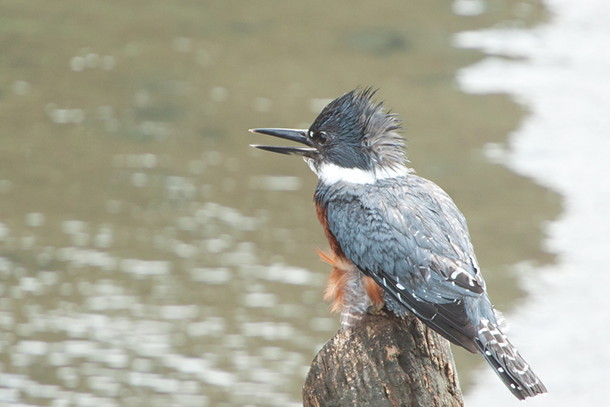
There are plenty of “king” species among our feathered friends, like the Ringed Kingfisher, but no “queen” birds to speak of. (Photo: Flavio Camus)
[MUX - BIRDNOTE® THEME]
CURWOOD: The scientific disciplines are increasingly trying to attract women, to correct a long-standing imbalance that heavily favors men. And in today’s BirdNote®, Michael Stein points out that it’s not only bench science where the female of the species is drastically underrepresented.
http://birdnote.org/show/where-are-all-queen-birds
BirdNote® Where Are All the Queen Birds?
STEIN: On an island in the Southern Ocean, a pair of King Penguins:
[King Penguin pair calls, ML 42302]
In Central America, an enormous Ringed Kingfisher:
[Ringed Kingfisher calls]
While nearby, a Thick-billed Kingbird calls:
[Thick-billed Kingbird call, repeated]
There's a King Vulture, a King Eider, 89 species of kingfishers, 11 kingbirds, 3 tiny kinglets - at least 115 birds across the world with the word king in their name, and no queens. 10,000 bird species – and not one “queenfisher” or “queenlet.”
Elsewhere in nature, there's the Queen Snake, Queen Butterfly, Queen Angelfish, Queen Moth, queen bees, and queen ants. But perhaps the lack of "queen birds" isn't so mysterious. Nearly all the early explorers and naturalists who named birds were men. And when a bird flashed a colorful crown, male royalty must have come to mind first. Once upon a time, there was a species of bird-of-paradise named Queen Carola’s Parotia. Carola was the wife of King Albert the 1st of Saxony, who also had a bird named for him, the King of Saxony Bird-of-Paradise. Alas, the queen’s bird had its name trimmed to the more tidy “Carola’s Parotia.”
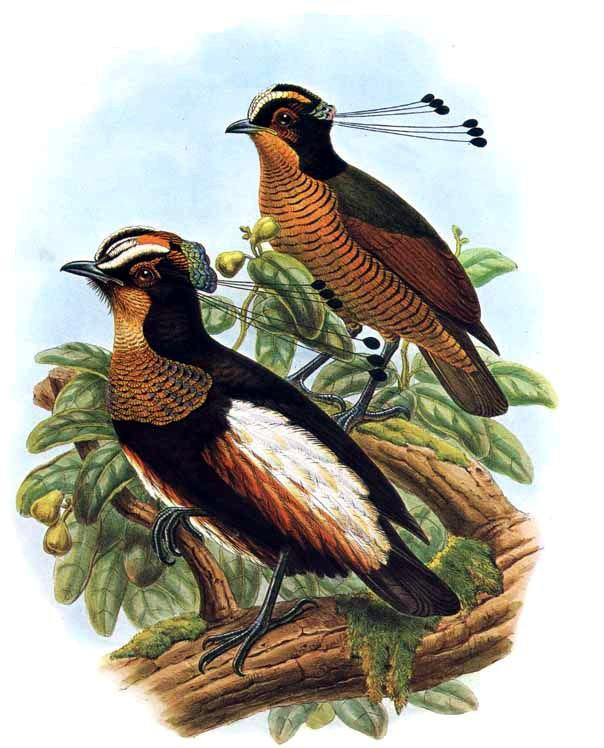
Carola’s Parotia used to be a queen, named after Queen Carola of Saxony, until the bird was dethroned because its name was too cumbersome. (Photo: Richard Bowdler Sharpe)
So today the scoresheet reads: King birds, one hundred and fifteen. Queen birds, zero.
I’m Michael Stein
###
Written by Bob Sundstrom
Bird sounds provided by The Macaulay Library of Natural Sounds at the Cornell Lab of Ornithology, Ithaca, New York. King Penguins [42302] recorded by Theodore A Parker III; Ringed Kingfisher [128045] recorded by Curtis A Marantz; Thick-billed Kingbird [109081] recorded by G A Keller
King Penguin image by Graham Canny flickr.com/photos/31918792@N03; Eastern Kingbird by P. Bonenfant; Ringed Kingfisher by Flavio Camus flickr.com/photos/chicuco; Carolia’s Parotia illustration by Richard Bowdler Sharpe
BirdNote's theme music was composed and played by Nancy Rumbel and John Kessler.
Producer: John Kessler
Executive Producer: Dominic Black
© 2015 Tune In to Nature.org February 2015 Narrator: Michael Stein
http://birdnote.org/show/where-are-all-queen-birds
CURWOOD: There are some regal photos at our website, LOE.org.
Related link:
Where Are All the Queen Birds?
[MUSIC: Steve Bean, Bohemian Rhapsody, Triple Point, Steve Bean, 2013]
CURWOOD: Coming up...a new book has practical advice for how to realize the dream of building a life on the farm. That's just ahead on Living on Earth. Stay tuned.
ANNOUNCER: Funding for Living on Earth comes from United Technologies, a provider to the aerospace and building systems industries worldwide. UTC Building & Industrial Systems, provide building technologies and supplies container refrigeration systems that transport and preserve food and medicine with brands such as Otis, Carrier, Chubb, Edwards and Kidde. This is PRI, Public Radio International.
[CUTAWAY MUSIC: The Sound Stylistics, The Players’ Theme, Play Deep Funk, Freestyle Records, 2007]
Woman Power and Small Farm Success
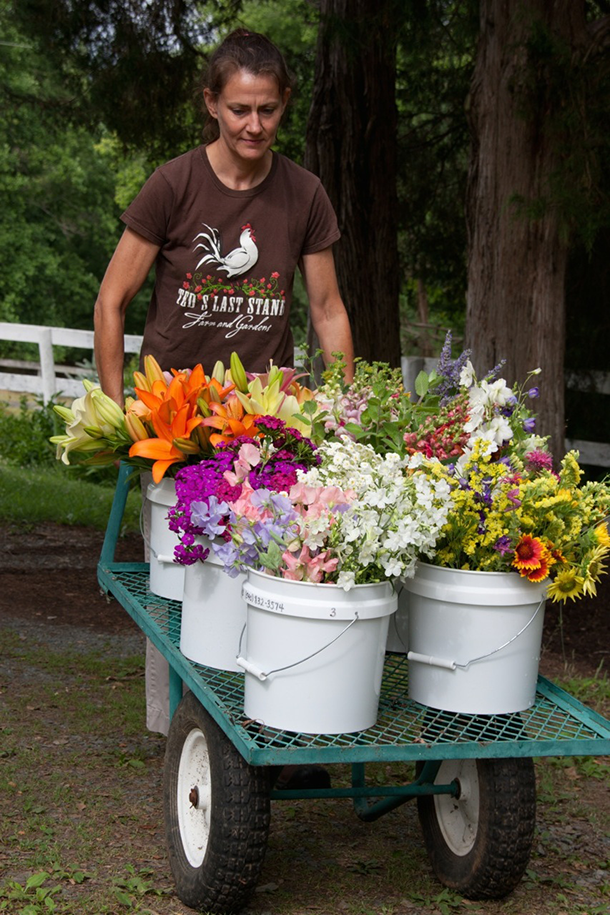
Audrey Levatino grows specialty cut flowers and sells them at local farmers’ markets to florists and restaurants, and for weddings. (Photo: Michael Levatino)
CURWOOD: It's Living on Earth. I'm Steve Curwood. It’s the busy season for small farmers all across America – when fresh produce at its peak must be harvested daily for the local farmers’ markets. And while women are usually the farmers in traditional societies, it’s a male dominated business in the US. But women are coming on strong these days, especially raising and selling local homegrown vegetables and flowers and jellies and chutneys.
One such farmer is Audrey Levatino, who has written a handbook for anyone seeking to grow local called "Woman-Powered Farm: A Manual for a Self-Sufficient Lifestyle from Homestead to Field”. Well, we thought this might appeal to anyone who fancies a bit of manual labor – so we called her up. Audrey, welcome to Living on Earth.
LEVATINO: Well, thank you so much. It's great to be here.
CURWOOD: So, why did you decide to write a book about farming specifically for women?
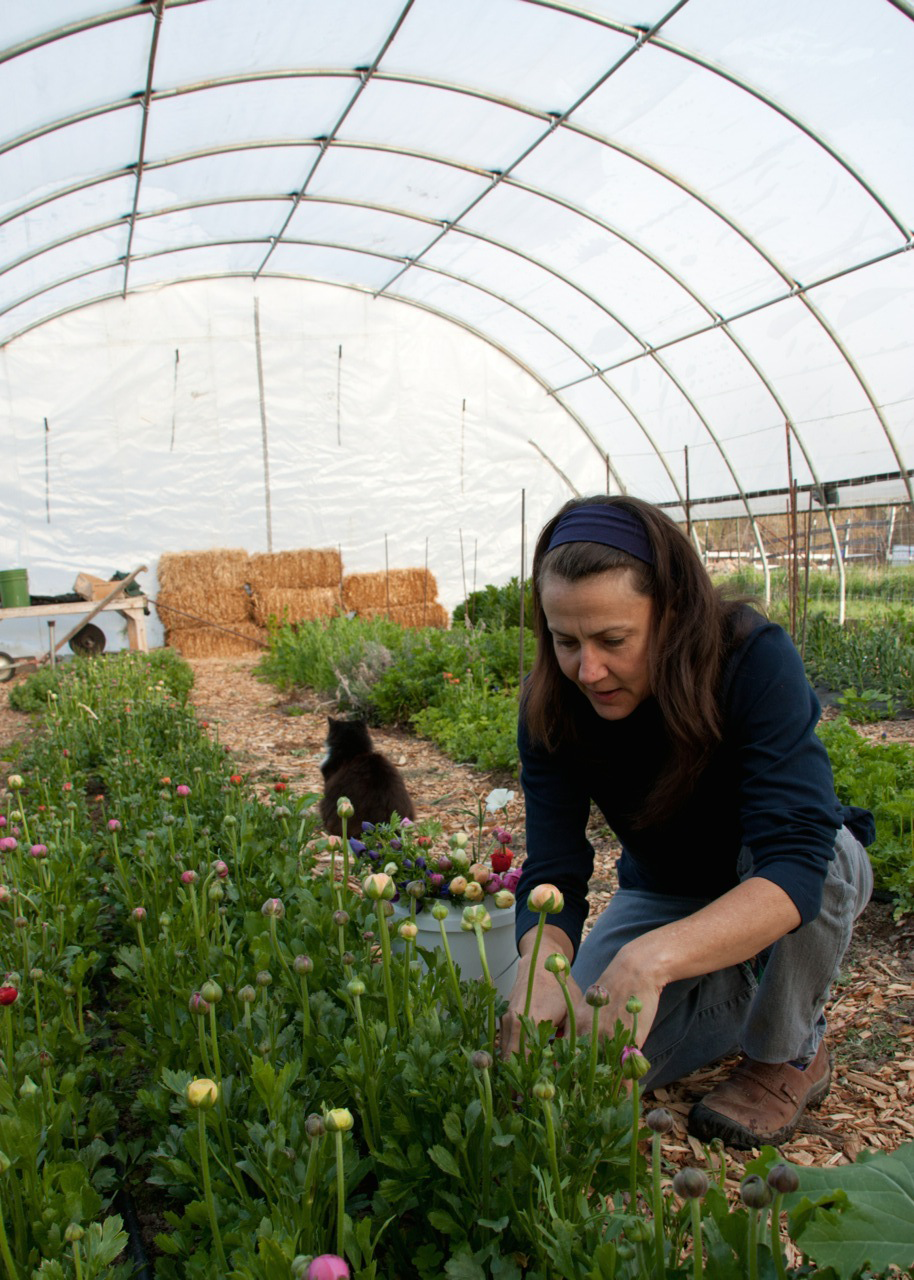
Audrey Levatino is the author of Woman-Powered Farm: Manual for a Self-Sufficient Lifestyle from Homestead to Field. With help from her husband Michael at the start, Audrey now grows numerous specialty cut flowers on their Virginia farm, Ted’s Last Stand. (Photo: Michael Levatino)
LEVATINO: Well, women were coming up to me at the farmers’ market and asking about what I did and were very interested. Many of them wanted to know how to get into farming and growing things themselves, and so they wanted advice and instructions on how to get started. Then I thought, most of these people are women around my age or younger, and when I first started out there wasn't just one book for a lot of the information that I wanted...I had piles and stacks of books. I started thinking about gathering all this information into one resource, a book just for women that addresses the concerns and interests that women farmers have.
CURWOOD: So what are the unique challenges that women farmers face as opposed to guys?
LEVATINO: Well, a lot of it is physical body strength. Men are built different than women so there's definitely going to be a bit of a different approach in terms of facing heavy-duty tasks. We really need to approach tasks with more creativity about how we can use our lower body strength and spare ourselves from injury, perhaps using wheels whenever we can instead of lifting up heavy buckets and carrying them, put them on a garden cart and wheel them over to where they need to be. There are many companies coming out with tools specifically designed for women to use. There's a shovel called HERShovel™ that has a wider foot base; you can get both your feet on there and really get some leverage and it has totally curved hook handles, you can get both hands and grip. There's an easy start chainsaw that's a little bit lighter weight and it doesn't take that really strong pulling motion, easy hitch and unhitch implements for tractors because that's really the biggest deal with using a tractor is getting those implements attached to the tractor - that's where the strength comes in, driving, anyone can drive something right? I hope. [LAUGHS]
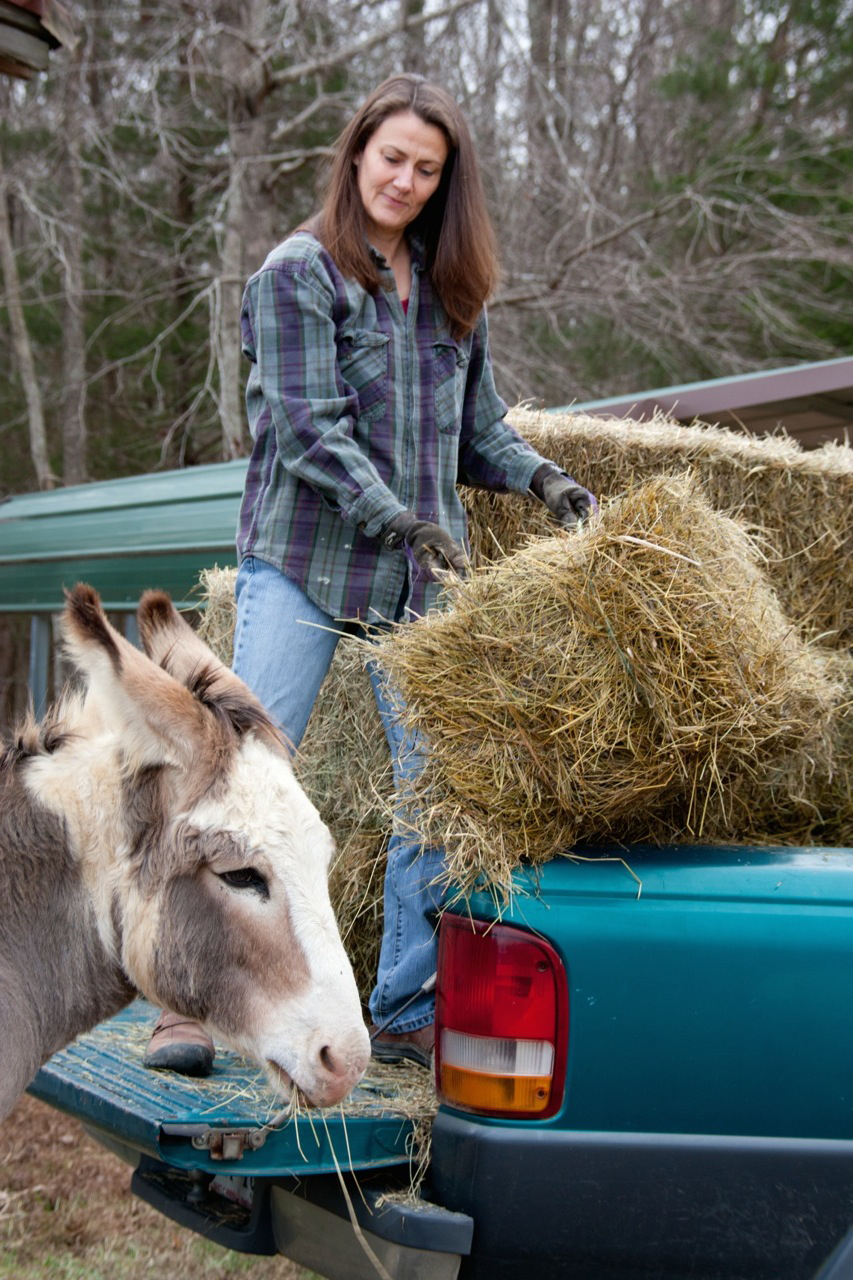
Whipper, one of two “gregarious” donkeys on Audrey’s farm, munches on some hay as Audrey unloads bales from the back of a truck. (Photo: Michael Levatino)
CURWOOD: Yes, but those attachments certainly can really weigh...in fact you have an interesting trick in your book, you say get a big iron crowbar to deal with attachments.
LEVATINO: Absolutely, I mean use that leverage! Again, I have another wonderful garden tool, the broad fork, and that's all about leverage. Use gravity whenever you can, make gravity work for you rather than against you.
CURWOOD: Audrey, what do women farm more typically as opposed to men?
LEVATINO: That's a great question, and that's another thing that I really investigated when I was writing the book and many women get into this farming business. It starts off as just wanting to provide the best and healthiest, most local food that they can for their families. So women are growing a lot of different things, but in many cases it is healthy, delicious, seasonal food. They know exactly where it came from, so that their children and their husbands and their neighbors can have the best food possible.
But the other thing that I discovered as I got further into my research and interviewed lots of women farmers in my area and around the country is women are just amazingly creative: they grow herbs and other medicinal plants to make cheese, salves and tinctures. Women also tend to farm, when they do livestock, smaller animals. You know, things that are a little more manageable and sometimes it's for fiber - sheep and llamas and alpacas - other times it’s for milk such as using goats to make cheese. So it's not just one specific thing.

Farming, Audrey says, isn’t just about doing the physical labor of growing and harvesting a crop; it also involves understanding the local market for the product. (Photo: Michael Levatino)
CURWOOD: Now, you write that many women have particular qualities that lend themselves well for farming. What do you mean by that?
LEVATINO: I myself don't have children but I interviewed many women farmers who do have children, and a common analogy that would come up when they were talking about being a farmer and the work of farming was having children. One of the qualities that women have, most women, is being very nurturing, and that's a big part of farming, not just for livestock but also for your plants and vegetables and paying attention and noticing when something starts to go wrong. Women are very good at having that sixth sense of: “that's not quite right” and being able to catch diseases and bug infestations sooner rather than later, and I'm not saying that men aren't good at that but that's just something that I noticed in talking to women that came up quite a bit. They're also willing to keep trying, and I think again these are qualities that men have, but I think in women it really is a huge benefit in farming to just keep trying again. If something doesn't work you're going to try something else.
CURWOOD: Audrey, paint a picture for us. What's a typical day like on your farm?
LEVATINO: Well, most farmers - I think this is universal - get up very early. You've got to get things done first thing in the morning. You've got to get up and feed those animals, let them out into pasture, water them - that's your first-order business - and if you're a plant farmer like myself - I grow mostly cut flowers - after I've fed my chickens, let them out of their coops, I go out and harvest. I spend my earliest coolest hours out in my flower fields harvesting flowers into buckets of water and I'll spend about two to three hours doing that in the morning and then I'll come in and take a break and eat some breakfast, check my e-mail, see if anybody has ordered more flowers, where do I need to go, what deliveries do I need to set up and then I go back out to the field.
The next order of business after harvesting is doing a thorough walk about—checking for bugs, eggs, on the leaves, aphids, any sort of disease that might be occurring in Virginia. We have a lot of humidity so rot can set in, and so I'm scooping bugs into water and feeding them to the chickens and then planting—getting in your next crop. If a crop needs to go in, then I need to prepare the row, put down landscape fabric if that's what needs to be done, get any crops planted for my next succession, and then weeding. That always falls to the bottom of the list and sometimes it doesn't get done, and sometimes if I have the time, social media, getting on and posting something on Facebook, putting something new on the website. But that also tends to get pushed down the list quite a ways.
CURWOOD: Audrey, why do you cultivate mostly flowers?
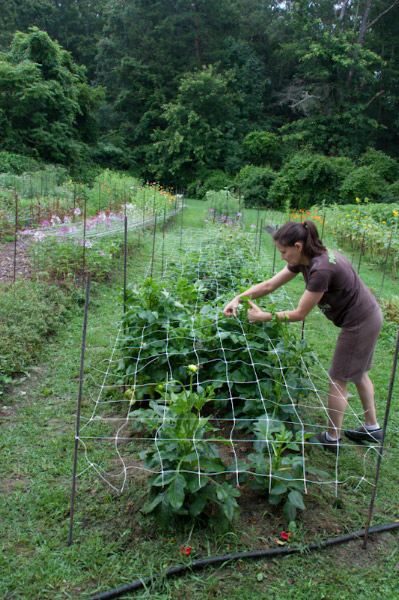
Audrey says she decided to cultivate flowers because she loves the bees they attract to her farm and the joy they bring to admiring customers at the farmers’ market. (Photo: Michael Levatino)
LEVATINO: I've always loved flowers and I got interested in it when I first started off with a vegetable garden. When I decided to make farming more of a full-time occupation, I looked around and was thinking about what might my market need. What would I enjoy doing? I love color and so I decided on flowers and just researched and started off small. Flowers, for one thing, they attract pollinators, and I really love having the bees and all of the butterflies and the birds. When you have as many flowers as I do, that's just constant, and it's wonderful, and also flowers make people happy. I love to see the smiles on people's faces when they see the flowers and just the joy that flowers bring to people.
CURWOOD: So tell me about some of these flowers you grow. What different kinds?
LEVATINO: It's all seasonal. I grow most of the stuff myself, starting from seed, and I grow things like Ranunculus, Anemones, Delphinium, Chinese Forget-me-nots, Canterbury bells, Matthiola...all of those are really nice spring crops that like to get started in cool weather and once it gets hot - once it gets up to like 85 degrees - they're not very happy so they stop blooming. I have two unheated covered structures, which are called either high tunnels or hoop houses. They're just basically big metal hoops with greenhouse plastic over them that are all covered up in the winter and then you roll the sites up in the summer so that the air can get in and cool things off. And that allows me to start some really beautiful spring crops early, so that I can have some cool weather crops, and then I move on into the summery crops -- of course I have Zinnias and sunflowers and Gladiola, Queen Anne's lace, Rudbeckia, of course Larkspur. As summer goes on, the Dahlias start blooming, which are always very popular. I get Euphorbia Kilimanjaro, which is this green and white flower, which is lovely. So it's very seasonal but to try and keep enough variety in there, so that I can make bouquets and fill orders for weddings that require a little more diversity.
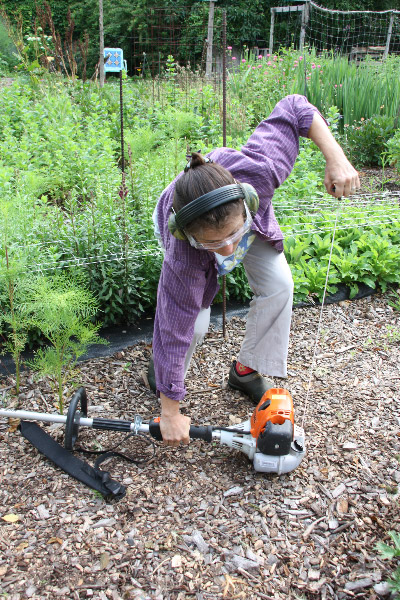
Audrey starts up a weedwhacker, determined to make a dent in the ever-encroaching weeds that threaten to crowd out her flowers. (Photo: Michael Levatino)
CURWOOD: Now, you didn't have much of a farming background when you started. How did you learn the skills that you needed to run your farm?
LEVATINO: I'm very much trial and error and go out and figure it out yourself, which means that I made a lot of mistakes and that was another reason I wanted to write this book and share it with people. Also I learned a lot from books, workshops; -- the agricultural extension agencies in state through your universities have wonderful workshops and programs that can introduce you to things - that's how I learned about bees. I took a class through my agricultural extension agency and started beekeeping. Take advantage of the resources that are out there that are, for the most part, free or very inexpensive. And the main resource that I would say any farmer needs is other farmers. You've got to go out there and find people in the community that are interested in what you're interested in that have been farming and that can be mentors because you're going to need help and that community of farmers is going to be a really strong support system for you.
CURWOOD: You write about one of your lessons in your book. You mostly do flowers but you also have donkeys and there is a story about the donkeys. Tell us the story.
LEVATINO: Well, first of all, we have about nine acres of pasture, and so when we first moved in and we felt like we really needed some grazing animals, the people who had owned the land before us had had horses. Horses are very high maintenance animals. Donkeys are about the lowest maintenance animal you can own, and they're also very cute and very gregarious. They are like having a couple of 350-pound unruly dogs. So we got the donkeys and just loved them.
All of our pasture is surrounded by woods, and we get windstorms and lightning. And the trees get old, and limbs break off, so the fence needs to be under constant surveillance. You've got to do the walking the perimeter and I let that slip and one morning I realized...we have one donkey that's very vocal and he didn't make the noises he usually makes when a car starts up on our road and so when I went out to look for him, I found a breach in the fence and the story is about being unprepared for that circumstance and how I ended up dealing with it, and part of that was really relying on the community - neighbors and farmers and friends. But it was also a lesson in making sure that your fence is always in good repair.
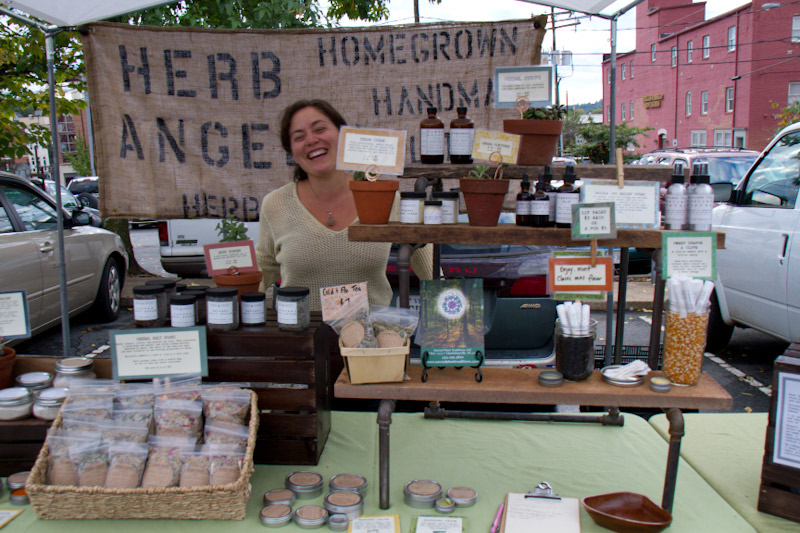
Angel Shockley, one of the women farmers Audrey profiles in her book, makes and sells herbs, teas, tinctures, and salves through her business, Herb Angel. (Photo: Michael Levatino)
CURWOOD: Indeed, mending fences is important, including with your neighbors. What did these donkeys do when they got out as far as your neighbors were concerned?
LEVATINO: [LAUGHS] Well, when I first reported it to animal control I said, I'm missing a couple of donkeys...they got out, and if anyone sees them can you let me know? About an hour later he called me back and apparently -- in quotations –“two white horses had been seen procreating in somebody else's yard”. And so that was the first sighting of the errant, wayward donkeys.
CURWOOD: [LAUGHS]
LEVATINO: And they're half-brothers and they just mess around like dogs, kind of mounting each other and wrestling, so this was quite embarrassing and also amusing really after-the-fact.
CURWOOD: So what was the biggest surprise that you encountered, as you went into farming and then went on to write this book to encourage more women to farm?
LEVATINO: When I first started out farming, my husband - he's had the same job but he wasn't quite as busy with that job - and so she was available to help me with a lot of things and that's how I learned how to do these chores, like using the chainsaw, and driving the tractor and cleaning the chimney. When he wasn't able to help me anymore I realized, wow, this is really, really hard work.
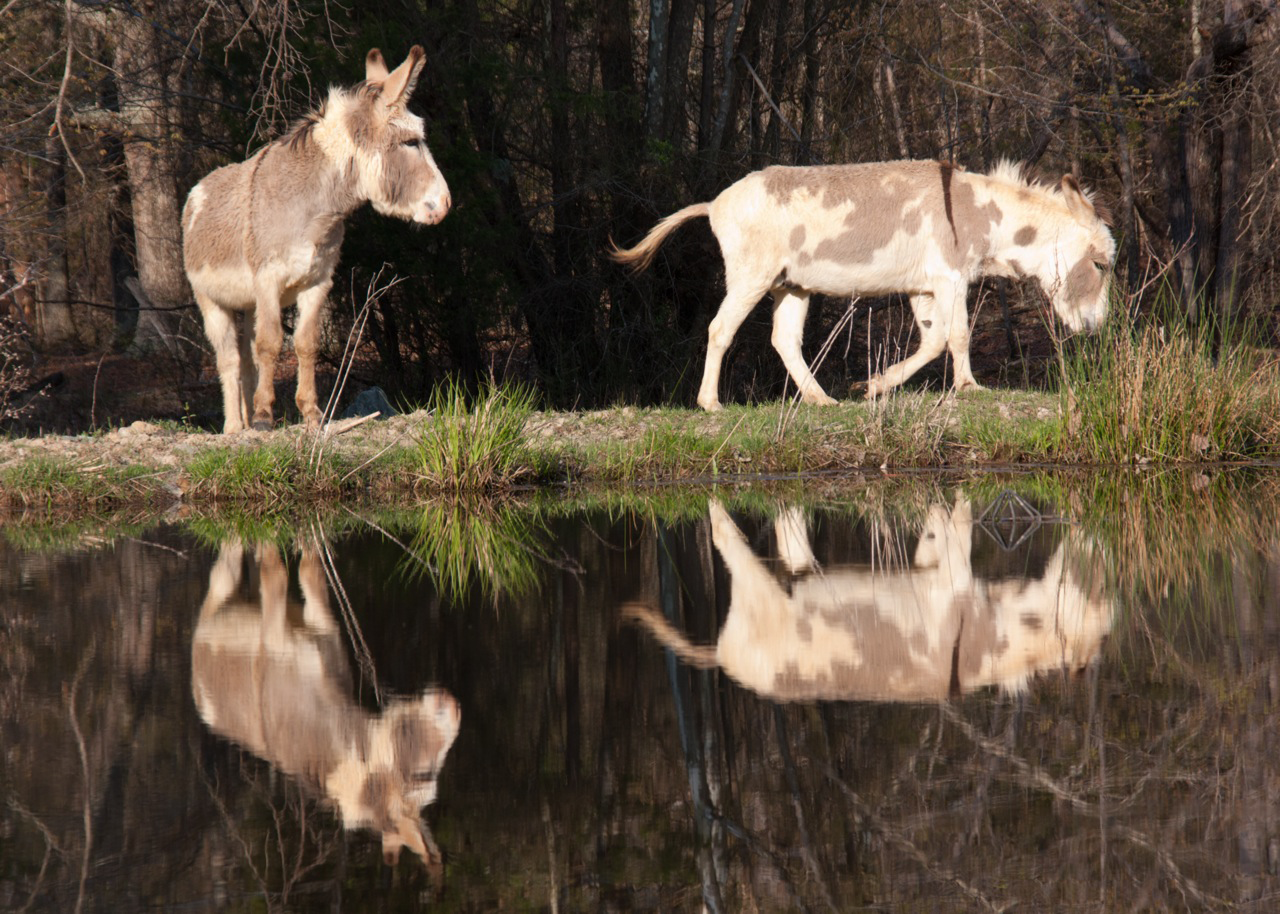
In a section of her book titled “The Great Donkey Escape,” Audrey details the story of how her donkeys, half-brothers Tyler and Whipper, escaped through the fence one day. Audrey found the donkeys later that day, but not before a neighbor noticed the brothers playing one of their favorite games—mounting each other. (Photo: Michael Levatino)
Being a farmer is really tough. You have to be self-motivating, have your own business plan, so it's not just doing the farm work, it's doing the accounting and planning out your succession plantings and your crops for the year and not just one year maybe two years and having an alternate plan because there's always to be a weather incident or some sort of crop failure or a market's going to fall through and you have to know your market, you have to do the research, you have to stay innovative and on top of the game, so I think I underestimated how many hats I would have to wear to actually make this job and make my business a success.
The other surprise was really just how much you end up loving it and being committed to it and having this fellowship and community feeling with other people that are in the same type of work and how that really builds a sense of belonging that I hadn't felt in this community before.
CURWOOD: Audrey, for whom did you write this book?
LEVATINO: Well, I wrote it to encourage and help inform women that are thinking about going into farming, but aren't quite sure or are hesitant about whether they think they're capable of doing it so it's really just a book that's for encouraging people to take that step. If you think you want to farm something, if you think you want to have a garden, if you think you want to start raising livestock, do it, take a chance. Of course, go out and explore and learn how to do it and then trust yourself.
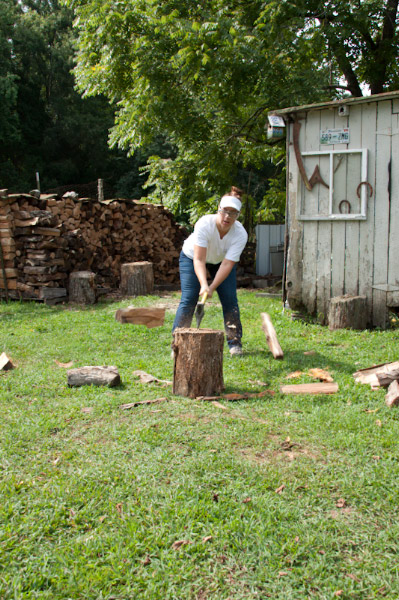
Woman-Powered Farm includes how-to spreads on essential farming skills, such as chopping firewood, that take into account the particular abilities of women. (Photo: Michael Levatino)
CURWOOD: Well, for anyone who’s listening to us talk and is curious about farming, there's quite a bit of real practical information about what you need to do to get going on a small organic hand-raising scale. If you want to go into commodities soybeans probably this is not the book for you. So last question, why did you pick this approach? You know that the vast majority of agriculture in this country is done on the industrial scale.
LEVATINO: Right. Right. Well and again that is a trend that women are leading the change in that by having these smaller independent farms that raise specialty crops and niche crops and are getting away from that idea of Big Ag. Big Ag is certainly important, we've got a lot of people in this country and other countries to feed, but getting closer to the land and really raising food and taking care of the planet that the food comes from is part of that movement that I think women are in the forefront of. So I wanted my farm to grow just as organically as everything else does. Basically I've created quite a little sustainable ecosystem: I have a pond, I have a mushroom grove, I've got the bees. So trying to create a balance in the nature on my property where everything works together and helps each other and is interdependent. I think and I hope that it's just again that nurturing attitude which is taking care of the Earth, as well as taking care of the people on the Earth.
CURWOOD: Audrey Levatino is author of "Woman-Powered Farm: A Manual for a Self-Sufficient Lifestyle from Homestead to Field”, and farmer of Ted's Last Stand Farm and Gardens. Audrey, thanks so much for taking the time with us today.
LEVATINO: Thank you.
Related links:
- About Woman-Powered Farm
- Ted’s Last Stand Farm
- The Women, Food & Agriculture Network (WFAN)
- About the USDA’s Extension program provides farming education and resources
- The HERS Shovel and other farm tools for women
- Picturing Women Farmers photo essay
[MUSIC: Matteo Salvatore, Mo Ve'la Bella Mia De La Montagna, Big Night Soundtrack, 1996]
[BELLS AND SHEEP BLEATING: Steven Feld “Gragnana, Italy”, VOXLOX 2004]
CURWOOD: We leave you this week in the company of sheep.
Benito is bringing his 50-belled sheep down for milking to a village above Carrara in the marble mountains in Tuscany as the church bell rings to signal a funeral.
[CHURCH BELL TOLLING, SHEEP AND DOG BARKING]
These sounds come from the Smithsonian Folkways CD The Time of Bells, produced and recorded by Stephen Feld.
[BELLS AND SHEEP BLEATING]
Living on Earth is produced by the World Media Foundation. Our crew includes Naomi Arenberg, Bobby Bascomb, Emmett FitzGerald, Lauren Hinkel, Shannon Kelleher, Helen Palmer, Adelaide Chen, Jenni Doering, John Duff, and Jennifer Marquis. Our show was engineered by Tom Tiger, with help from Jake Rego, Noel Flatt and Jeff Wade. Alison Lirish Dean composed our theme. You can find us anytime at LOE.org - and like us, please, on our Facebook page - it’s PRI’s Living on Earth. And we tweet from @LivingonEarth. I'm Steve Curwood. Thanks for listening.
ANNOUNCER1: Funding for Living On Earth comes from the Grantham Foundation for the protection of the environment, supporting strategic communication and collaboration in solving the world’s most pressing environmental problems. Support also comes from the Kendeda Fund, Trinity University Press, publisher of Moral Ground; Ethical Action for a Planet In Peril, 80 visionaries who agree with Pope Francis, climate change is a moral issue for each of us. TUPress.org, and Gilman Ordway for coverage of conservation and environmental change.
ANNOUNCER2: PRI. Public Radio International
Living on Earth wants to hear from you!
Living on Earth
62 Calef Highway, Suite 212
Lee, NH 03861
Telephone: 617-287-4121
E-mail: comments@loe.org
Newsletter [Click here]
Donate to Living on Earth!
Living on Earth is an independent media program and relies entirely on contributions from listeners and institutions supporting public service. Please donate now to preserve an independent environmental voice.
NewsletterLiving on Earth offers a weekly delivery of the show's rundown to your mailbox. Sign up for our newsletter today!
 Sailors For The Sea: Be the change you want to sea.
Sailors For The Sea: Be the change you want to sea.
 The Grantham Foundation for the Protection of the Environment: Committed to protecting and improving the health of the global environment.
The Grantham Foundation for the Protection of the Environment: Committed to protecting and improving the health of the global environment.
 Contribute to Living on Earth and receive, as our gift to you, an archival print of one of Mark Seth Lender's extraordinary wildlife photographs. Follow the link to see Mark's current collection of photographs.
Contribute to Living on Earth and receive, as our gift to you, an archival print of one of Mark Seth Lender's extraordinary wildlife photographs. Follow the link to see Mark's current collection of photographs.
 Buy a signed copy of Mark Seth Lender's book Smeagull the Seagull & support Living on Earth
Buy a signed copy of Mark Seth Lender's book Smeagull the Seagull & support Living on Earth

